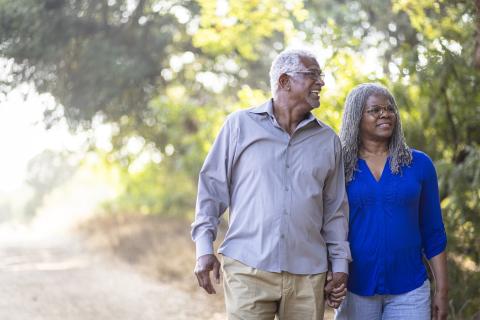Spending Time in Nature Provides a Health Boost for Older Adults
If you or an older loved one are still spending most of your time indoors, it’s time to consider ways to get into nature again. A number of studies show that spending time in green spaces—and in “blue spaces” near water—is good for the mental, emotional and physical health of older adults. University of Tokyo experts report that spending time in nature has been a major way elders are lessening some of the negative effects of social distancing. Here are some other documented benefits:
Improves brain health. Stress is bad for the brain, but nature can reduce stress. To learn just how much, experts from University of York, also in the U.K., equipped a group of seniors with sensors to monitor brain activity, and found that as the volunteers walked around an urban environment, their brain waves were calmer and quieter when they entered parks and planted areas.
Strengthens the immune system. A study from University of Surrey in the U.K. showed that we need vitamin D for a strong immune response, and that exposure to sunlight is the top way to get it. Vitamin D is also important for bone health.
Encourages exercise. Numerous studies show that people are far likely to be active when they are outdoors. A brisk walk is much more interesting than an hour on the treadmill or working out with an exercise video.
Promotes socialization. These days when it is safer to socialize in open air, the benefits of being outdoors are obvious. But even before the pandemic, studies showed that nature can bring us together. A University of Minnesota study even showed that older adults who go outdoors spend more time with younger people—and intergenerational contact provides a big mood boost.
Improves sleep. A study from the University of Illinois showed that older adults who have access to natural surroundings have better slumber. Said study author Prof. Diana Grigsby-Toussaint, “If there is a way for persons over 65 to spend time in nature, it would improve their quality of sleep and their quality of life.”
Decreases depression. For centuries, spending time in nature has been prescribed for emotional health. Have you heard of “forest bathing”? A practice that originated in Japan, this “eco-therapy” has many practitioners, who say sitting among trees improves the mood. A University of Michigan study even found that going for group walks in a natural setting could be an alternative to medications for older people who are dealing with painful life circumstances, such as loss of a loved one or serious illness.
Inspires the spirit. A study from University of California, Berkeley found that being in nature can give us a sense of something larger than ourselves, and feelings of perspective and well-being.
Lengthens life. For all the reasons above, people who spend time in nature tend to have greater longevity. And there is one more important factor: Wooded, planted areas also have a lower level of health-robbing pollution,
Finding opportunities to get outdoors
Almost every community has some sort of natural area. This might be a forest, a lake, a beach or a grassland. If you live in a desert area, the sounds and sights can be as inspiring as a dense forest. For older adults, the first step may be to learn about accessible outdoor opportunities. National and state parks, beaches and lakes and public gardens these days often feature paved trails and boardwalks that are suitable for wheelchairs and walkers. People with visual impairment can enjoy the sounds of birds, water and the wind in the trees.
And “the great outdoors” doesn’t only refer to a backpacking weekend or a trip to Yosemite. We can spend time among trees, water and growing things in a forest preserve, a park, the zoo or even in our own yard. Your local parks and recreation department may offer outdoor programs for older adults. If a senior living community is your home, spending time in the yard or courtyard can be pleasant. And ask about outings the community offers.
